|
| Schebler model D leaking investigatio... |
| Author |
Message |
    
Barry Millar
Advanced Member
Username: barry
Post Number: 35
Registered: 02-2006
| | Posted on Thursday, January 25, 2007 - 02:09 pm: | 




|
Many who use Schebler model D carburetors report that they leak even when engine is not operating.
Much has been reported identifying the float as the principal reason; particularly the need to ensure the float is adjusted so that fuel level is below nozzle level. While this is important, I observed that even when float is properly adjusted, static leakage sometimes still occurs. I investigated Float Valve Pins (item H attached drawing), thinking that leakage was occurring at valve seat… I removed this part from eight carburetors, an image is attached. Their condition suggested a probable link to the leakage so I undertook further investigation.
I machined a new Float Valve Pin, and then I constructed a simple test stand.
An image of my simple test stand is attached, also an image of the new Float Valve Pin along side an old one.
Here is what I then did. I set aside five Schebler model D carburetors for testing, removed the float cover so that I could observe the rise of gasoline in the float chamber.
Then, I attached each carburetor in turn to the test rig, connected the fuel supply hose, turned on fuel and observed approximate time for fuel level to increase above the float and then drip into the plastic container located underneath. Then I replaced the Float Valve Pin with the new one and repeated the test.
With the original Float Valve Pin installed, one leaked within 30 seconds, three leaked in about three minutes, one did not leak after 5 minutes (fuel did not rise above top of float). If the carburetor that leaked in 30 seconds were used with an engine, leakage rate would exceed fuel consumption rate, so probably constant flooding would occur.
Here is he interesting result. None leaked when the new Float Valve Pin was installed.
I previously posted information regarding fule level and float setting, however I will post it again as it has to do with Schebler leaking. This prior test suggests that the float setting is not very critical even though Schebler original instructions suggest otherwise.
“ Regarding float valve setting, I conducted a brief test.
When the test engine was operating under maximum load, I turned off fuel supply and recorded RPM at 5 second intervals until the engine stopped.
Engine speed remained constant at 840 RPM, +/- 2 RPM for 2 1/2 minutes then fell rapidly to zero during a final 5 seconds.”
The bowl was almost empty
Barry
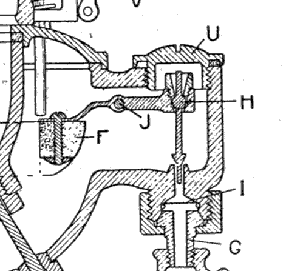
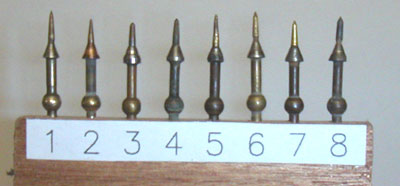
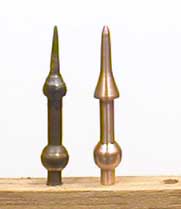
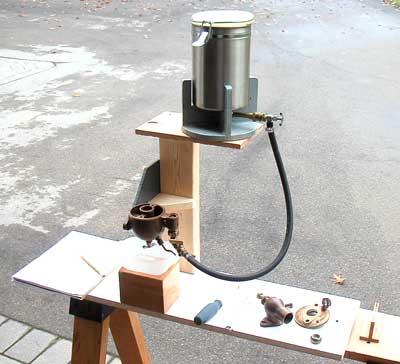 |
    
J.B. Castagnos
Senior Member
Username: jb_castagnos
Post Number: 224
Registered: 07-2002

| | Posted on Thursday, January 25, 2007 - 06:57 pm: | 




|
Nice work on the needle Barry, did you machine the ball freehand? Most of the Scheblers I've seen had a composite needle, the seat area looked like lead or babbit, I'm sure this was the predecessor to the neoprene seat. If the solid brass works well you can't argue with success. I would think float level would be more sensitive at idle when air is moving slow than at high speed. If you have a chance I would like to see the results of a low speed test. |
    
Richard A. Day Jr.
Senior Member
Username: richardday
Post Number: 455
Registered: 11-2003

| | Posted on Thursday, January 25, 2007 - 08:30 pm: | 




|
When I run into this problem I give the valve stem a small rap with a pin punch and ball peen hammer. I also found Ernie's trick bending the float level down works much better at shows when idling all day. I should add the cast float levers don't bend easily. |
    
Ernie
Senior Member
Username: ernie
Post Number: 541
Registered: 01-2002

| | Posted on Thursday, January 25, 2007 - 08:50 pm: | 




|
Richard,
Just like a new non viton needle and seat. As part of the installation you needed to give it a little tap to make/fit the seat. Just look at carb kit instructions from before the days of viton tip needles |
    
David Myers
Member
Username: dave_myers
Post Number: 17
Registered: 11-2006

| | Posted on Thursday, January 25, 2007 - 10:04 pm: | 




|
Hi Richard,Ernie & JB,
You guys probably know this. I dont know about after market needles but on the originals, the 'Ball' on the needle is a friction fit to the stem and you move this up or down with a small tube to fit over the stem and give it a tap to adjust the float level. Bending the float lever usually ends in having to find a new one after it breaks. Getting hard to find down here in OZ these days.
I also dress the seat with a 1/8th drill bit and then drop a 1/8th ball bearing on the seat and tap with a pin punch to create a uniform seal. Do not have any troubles with leaky carbies now. Took me a while to learn tho.
Dave |
    
Richard A. Day Jr.
Senior Member
Username: richardday
Post Number: 456
Registered: 11-2003

| | Posted on Friday, January 26, 2007 - 08:38 am: | 




|
My experience with bronze is you get one smal free bend but the real problem is with the cast units getting at the shaft to bend it. I have found a lot of model Ds and similar have levers that are brass straps that bend quite easily with a tool you make up from a piece of 1/8"steel stock about 1/2" wide by 3" long. Cut a hack saw blade width slot on one end about 3/4 across the stock. You can then slip the tool over the float lever and bend it easily. You can also use the show alternative simply press down the lever holding the valve end down at the same time.
Incidentally anyone needing a NOS original cast
bronze float lever for the 1-1/2" Model D I have a few simply because there is no longer any great demand for that large carburetor. Cannot help on the smaller units any more. |
    
Barry Millar
Advanced Member
Username: barry
Post Number: 36
Registered: 02-2006
| | Posted on Friday, January 26, 2007 - 12:08 pm: | 




|
Many thanks for the replies. These raise further questions and suggest more discussion.
1 Ernie, do you know of a source for Float Valve Pins with Viton tips? None of my carburetors pins have soft tips. Do you know if it a later date Schebler used these?
2 JB, the image of the eight pins shows that some were coated with what was probably lead / tin solder to make a soft seat. I had the new pin made from silicon bronze, which is preferred compared to brass, which is probably too soft. I used silicon bronze, as I happened to have a bronze cap screw. Possibly aluminum bronze would be preferred as it machines better or maybe 303 (machinable) stainless.
3 Dave, I did not realize the ball was a separate piece and could be adjusted to set float level. This is great information, thanks for posting it. This puts a new slant on the subject at hand.
I examined a few pins under a 10-power glass and there is evidence that the ball is a separate piece. Has anyone seen reference to this in Schebler literature?
I initiated inquiries to purchase 3/16 bronze balls. I am sure they are inexpensive and easy to find. I plan on buying some and drill/ream a hole, then make some pins with a friction fit so the ball can be adjusted to set float level (using a simple jig). This is a much, much better solution than bending the strap.
Already I‘ve found a Company that will supply balls with a drilled hole. I suspect this is custom work so a large quantity would be needed to obtain an attractive price, so will probably end up drilling them here.
4 Richard, I have previously bent the sheet metal brass strap to adjust fuel level. In the case of cast straps, I use a shim (refer to image attached). This is a very time consuming process as I found it to be a trial and error method and as a result not fun. Using the adjustable ball method will in my opinion be much faster and accurate, thanks again, Dave.
Incidentally, the simple test set up shown in the image attached to my Jan 25 post facilitates the procedure, as it is easy to measure fuel level and nozzle level using a Vernier, standing rather than kneeling in a confined space.
I coat cork and synthetic floats with epoxy and use epoxy to attach shims. I am not concerned about the added weight of epoxy as long as they still float as fuel level can be adjusted. Now, with an adjustable ball, shims and strap bending may not be required.
5 When I examine the eight pins (reference image attached to my Jan 25 post) in all cases the pin seat area is badly worn and seems to be reason for leaking. This was confirmed by my tests as leaking stopped using a new pin without refurbishing the mating seat. It seems to me that if it’s possible to avoid refurbishing the seat, this is desirable.
6 JB, I made a note to do some test bench trials this spring, with fuel level adjusted
maybe ¼” below nozzle to determine if this affects slow speed operation or makes starting difficult.
7 I checked a Float Valve Pin from a Kingston Carb. It is identical to the Schebler, as is the cap, item U. Maybe other carbs use identical parts? Maybe an independent made them.
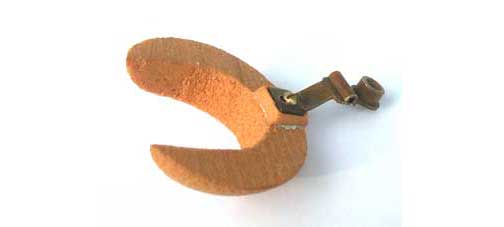 |
    
Richard A. Day Jr.
Senior Member
Username: richardday
Post Number: 457
Registered: 11-2003

| | Posted on Friday, January 26, 2007 - 08:36 pm: | 




|
Thats a new one to me too. Will have to look and see if any of the valves I have are adjustable. I do have several that came from Arcadia when they closed up shop back in the 70s. They appear to be stainless steel. Will have to see if they are adjustable. Incidentally Barry very nice work on your part. |
    
Ernie
Senior Member
Username: ernie
Post Number: 542
Registered: 01-2002

| | Posted on Saturday, January 27, 2007 - 01:57 pm: | 




|
Barry,
Viton tips came about in the mid to late 60's. Schlebler was long gone by then. Acadia and Atlantic in Nova Scotia made these carbs into the 80's and Atlantic may still make a few. However they were all brass needles. At least the ones that I have seen. |
    
Barry Millar
Advanced Member
Username: barry
Post Number: 42
Registered: 02-2006
| | Posted on Thursday, February 22, 2007 - 07:01 pm: | 




|
Following up on David Myers January 25 post, I corresponded with Garry Edwards who lives in Sydney.
Garry advised that an Australian Company, Alpha Carburetor Manufacturing Company made Schebler style carburetors with the adjustable ball float valve.
Garry sent me the attached image.
Barry
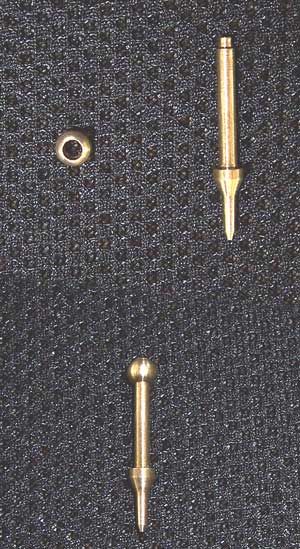 |
    
Robert
Senior Member
Username: robert
Post Number: 855
Registered: 07-2003
| | Posted on Thursday, March 23, 2017 - 11:59 am: | 




|
Thanks to all for the great info here gents, very educational. Looking at the first drawing in the first post, I'm wondering if leaking could also be due to the ball not moving freely in its mounting and causing the tapered shoulder to not seat completely. With only the force of the leverage exerted by the float to push it down into the seat, and with no lubrication on the ball except the fuel, I can't help wondering if a built up of fuel contaminants, corrosion etc. might cause the ball to stick in its mounting and not seat reliably.
I also wonder what would be causing the wide variety of wear, (I assume it's wear), patterns on the pins Barry examined and shows in the photo above? Just rising and falling with the level of the float causes that? What does it do to the seats then? On a square shouldered hole the pin could wear it oval and cause leakage, on a taper shouldered hole one would expect the wear to occur below the taper and so not cause leakage.
Is the seat for the tapered shoulder square cornered, or tapered to match the shoulder on the pin, or is that something that changed over the course of Model D production?
Is wear to the Pivot Shaft and Pivot Nuts, or sticking of the shaft, not also likely to be a source of overfilling and leakage problems? |
|
|
|


|


